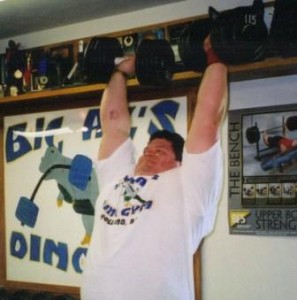Barbells Up, Dumbbells Down Part 1 – Dumbbell Training
by John McKean
Paul Anderson, Louis Cyr, Arthur Saxon, Hermann Goerner, Doug Hepburn, and John McKean. The question behind this answer is, “Name five all-time superstars of strength who extensively employed heavy dumbbells in training, and one other guy!” Of course, yours truly is the lowly other guy, but I do enjoy standing on the shoulders of these giants to seek some of the progress they found through brutally-intense dumbbell work.
Unfortunately, most dumbbell work nowadays is relegated to lightweight shaping movements, or, at most, relatively high-rip, non-goal oriented exercise with poundages that are “comfortable”. I don’t even like to recall how many gyms I’ve visited where the heavy half of the dumbbell rack is as dusty and untouched as their bench uprights shiny and worn.
Why is this? Simple – dumbbells hurt. That is, in exactly the opposite manner to how exercise machines ease and rob the work of a similar barbell move, dumbbells call for even more total bodily involvement than a long bar. Where machines isolate, dumbbells, on the other hand, require extreme control, utilization of many stabilizing muscles, coordination between muscle groups, and total concentration. They have a longer range of motion than barbells or machines, and bombard deep-lying muscle fibers from many different angles. Most importantly, with some intense effort, seriously-heavy dumbbells eventually adapt to our own personal groove – we’re forced to learn to control the weighty little beasts, and best compensate for out individual leverages. Eventually, then, we discover (perhaps even subconsciously) our own optimum angles of push or pull, to capitalize on innermost strengths.
Many of the old-time strongmen never seemed to lack incentive to go to limit poundages on dumbbell lifts. Of course, back then they regularly contested dumbbell clean & jerks, presses, snatches, swings, and the crucifix. A look at U.S. and British record lists printed in magazines from the 1920s and 30s will show a slew of dumbbell marks which were recorded under official conditions. Do we have any such incentive today? You bet! Under the auspices of the IAWA we currently have 27 registered dumbbell lifts to go after. And, brother, if you thought my insistence on training barbell limits in past articles was taxing, I’m really setting you up for a wonderful world of pain this time.
No, you may not be interested in jumping into one of our dumbbell competitions – the British would call these “single arm championships” – but you sure can obtain huge overall strength gains while bringing out previously unnoticed lumps, bumps and strands of muscle. All that’s required is the desire to see just how heavy a single rep you can eventually achieve with one or more dumbbell lifts. Specialize if you care to, or build a total routine on 4-10 dumbbell moves per week.
